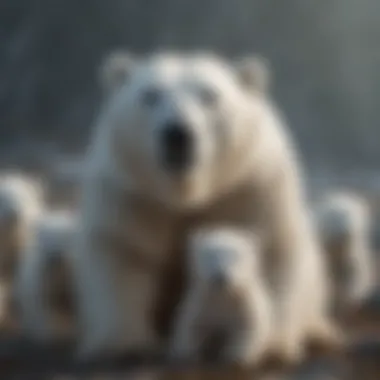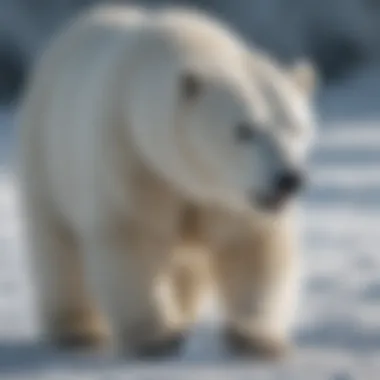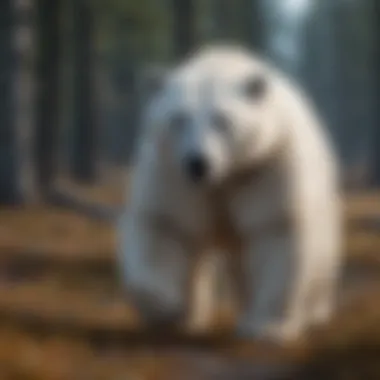The Fascinating Lifecycle of Polar Bears: From Birth to Maturity Unveiled


Nature Topic Overview
Polar bears, the iconic giants of the icy Arctic regions, navigate a fascinating lifecycle characterized by unique challenges and remarkable adaptations. From their birth in the frozen wilderness to their journey towards maturity, these majestic creatures offer a glimpse into a world of resilience and survival strategies amidst the harsh polar conditions.
Fun Facts and Trivia
- Polar bears are the largest land predators on Earth, with powerful paws that can measure up to 30 centimeters in diameter, ideal for traversing the icy terrain.
- Unlike other bears, polar bears are superb swimmers, capable of covering long distances in search of food such as seals.
- Their fur appears white but is actually translucent, covering a layer of black skin that absorbs the sun's heat to keep them warm.
Wildlife Explorations
Exploring the Arctic ecosystem reveals an intricate web of interconnected species. From the elusive Arctic fox to the resilient Arctic flora, each component plays a vital role in sustaining this delicate environment. Engage in interactive quizzes and puzzles to uncover the secrets of these fascinating creatures and plants in the polar realm.
Environmental Awareness
The conservation of polar bear habitats is crucial for the preservation of these magnificent creatures. Learn about the impact of climate change on Arctic ice and discover how you can contribute to sustainability efforts. Implement simple practices in your daily routine to help protect nature and support the survival of Arctic wildlife.
DIY Nature Activities
Embark on hands-on nature activities designed to enhance your understanding of polar bear habitats. Create crafts inspired by the Arctic landscape, such as snowflake art or polar bear paper sculptures. Venture outdoors to apply your newfound knowledge through exploration and observation of local flora and fauna.
Introduction
At the core of understanding the enigmatic realm of polar bears lies the pivotal concept of their lifecycle. This article embarks on a prodigious exploration of the phases spanning from birth to maturity in these remarkable creatures. Delving into the intricacies of their existence in the unforgiving icy wilderness, this narrative endeavors to unveil the challenges faced and the extraordinary adaptations undertaken by polar bears to ensure their survival.
About Polar Bears
Characteristics of Polar Bears
The intrinsic characteristics of polar bears are a testament to their unparalleled resilience and aptitude for survival in the Arctic domain. Their massive size, thick white fur, and webbed paws enable them to thrive in frosty terrains where other species falter. The adept swimming abilities of polar bears, coupled with their exceptional sense of smell, form a formidable combination that aids them in hunting and navigating their habitat with remarkable efficiency. These unique characteristics make polar bears a fascinating subject for this article, shedding light on their evolutionary advantages in the challenging Arctic environment.
Habitat of Polar Bears


The Arctic region serves as the primary habitat for polar bears, encompassing expanses of ice, snow, and frigid waters essential for their sustenance. This harsh environment, characterized by extreme cold and scarce food sources, shapes the behavior and lifestyle of these majestic creatures. The wide expanse of the Arctic sea ice plays a crucial role in providing platforms for hunting seals, a staple diet for polar bears. However, the very habitat that sustains them is under threat due to climate change, highlighting the precarious balance these animals must maintain to survive. Exploring the habitat of polar bears unveils the intertwined relationship between their existence and the Arctic environment.
Importance of Studying Polar Bear Lifecycle
Research Implications
Studying the lifecycle of polar bears yields valuable insights into their behavior, ecology, and responses to environmental changes. Research implications delve into the scientific contributions derived from understanding the intricate stages of a polar bear's life, offering key data for conservation efforts and wildlife management strategies. By deciphering the nuances of polar bear behaviors and adaptations, researchers can formulate informed decisions to safeguard these vulnerable species in a rapidly transforming world. The research implications of studying the polar bear lifecycle underscore the significance of ongoing scientific inquiry for the preservation of Arctic ecosystems and biodiversity.
Conservation Efforts
Conservation efforts aimed at protecting polar bears involve a multifaceted approach encompassing habitat preservation, climate action, and community engagement. The conservation initiatives strive to mitigate human-induced threats such as habitat loss, pollution, and climate change that endanger polar bear populations. By raising awareness, implementing protective measures, and advocating for policy changes, conservationists work tirelessly to secure a sustainable future for these iconic Arctic inhabitants. The conservation efforts outlined in this article illuminate the collective endeavor to safeguard polar bears and the delicate ecosystem they inhabit, emphasizing the crucial role of conservation actions in ensuring their continuity.
Birth and Early Life
Importance of Birth and Early Life
The birth and early life stage of a polar bear is crucial as it sets the foundation for its survival in the harsh Arctic environment. Understanding the intricacies of cub birth and maternal care is essential in comprehending how these majestic creatures adapt and thrive. Birth and Early Life provide valuable insights into the resilience and resourcefulness of polar bears, shedding light on their unique adaptations to survive in icy habitats.
Cub Birth
Gestation Period
The gestation period of a polar bear plays a pivotal role in the reproductive cycle of these Arctic giants. Lasting around 8 months, the mother prepares for birth in a secluded den, ensuring the cub's safety and warmth. The extended gestation period allows for the cub to develop fully before entering the world, a crucial adaptation for their survival in extreme temperatures. Despite its challenges, the gestation period is a strategic mechanism ensuring the cub's viability and resilience in the Arctic wilderness.
Denning Behavior
Denning behavior is a hallmark of a polar bear's reproductive cycle, where the pregnant female retreats to a den to give birth and nurture her offspring. The den provides insulation against the cold, safeguarding the vulnerable cub during its initial stages of life. The mother's denning behavior showcases her commitment to protecting her young, demonstrating the instinctual maternal care vital for the cub's early development. Although denning requires seclusion, it offers a safe haven for the cub to grow and thrive in a hostile environment.
Maternal Care
Nursing and Growth


Maternal care encompasses nursing and growth, fundamental aspects of a polar bear's early life. The mother's rich milk provides essential nutrients for the cub, promoting rapid growth and development. Nursing fosters a strong bond between the mother and cub, facilitating a nurturing environment crucial for the cub's survival. The careful balance of nursing and growth ensures the cub's physical strength and prepares it for the challenges ahead in the Arctic terrain.
Mother-Cub Relationship
The mother-cub relationship underpins the social structure of polar bears and guides the cub's learning experiences. The mother imparts vital hunting skills and survival techniques to her young, ensuring their self-sufficiency in adulthood. The bond between mother and cub is enduring, fostering emotional connections that enhance the cub's overall well-being. Through the mother-cub relationship, polar bears instill essential behaviors and instincts necessary for thriving in their icy habitat.
Adolescence and Maturity
In the enthralling saga of a polar bear's lifecycle, the phase of Adolescence and Maturity holds a crucial position. It serves as a pivotal stage where young bears transition from dependence to independence, acquiring vital skills for survival in their icy domain. Understanding Adolescence and Maturity sheds light on the evolution of these majestic creatures within their unforgiving environment, uncovering how they learn to navigate the challenges they face.
Learning to Hunt
Self-Sufficiency
The concept of Self-Sufficiency plays a fundamental role in a polar bear's journey towards adulthood. It epitomizes the bear's ability to sustain itself autonomously, showing a profound resilience in securing its nourishment. Through Self-Sufficiency, polar bears demonstrate a remarkable self-reliance that ensures their viability in the harsh Arctic conditions. This trait promotes the bear's adaptation to its environment, enabling it to thrive independently without relying on external factors for survival.
Hunting Techniques
A significant aspect of a polar bear's development is mastering various Hunting Techniques. These strategies are honed to perfection through adaptation and experience, providing the bear with effective means to secure its sustenance in the vast expanse of the Arctic. Each Hunting Technique embodies a specialized approach tailored to different prey, showcasing the bear's versatility and ingenuity in capturing its meals. By assimilating diverse Hunting Techniques, polar bears enhance their predatory skills, elevating their efficiency as apex predators within their habitat.
Social Behavior
The Social Behavior of polar bears offers a glimpse into their intricate interactions within the Arctic ecosystem. Observing how these beings engage with one another reveals their dynamics in social settings, unveiling the complexities of their communication and hierarchy. Interactions with Other Bears are essential for fostering social bonds and establishing territories, encouraging cooperation among individuals for shared benefits. Furthermore, Mating Behavior illuminates the reproductive strategies employed by polar bears, shaping the genetic diversity and survival of future generations. It underscores the critical role of partnerships and courtship rituals in perpetuating the species amidst challenging environmental conditions, highlighting the importance of social connections in sustaining their population.
Survival Strategies
In this section, we delve into the critical topic of Survival Strategies adopted by polar bears. Understanding the diverse adaptations these mighty creatures employ is crucial to appreciating their resilience in the face of extreme environmental conditions. By elucidating the meticulous foraging techniques, shelter-building prowess, and energy conservation methods that polar bears utilize, we gain profound insights into their survival in the harsh Arctic landscape. Exploring the behavioral adjustments and physiological enhancements that enable polar bears to thrive in a climate of change highlights the depth of their evolutionary capabilities.
Adaptations to Climate Change
Impact of Global Warming


Investigating the Impact of Global Warming on polar bears reveals the detrimental consequences of rising temperatures on their natural habitat. The accelerated melting of Arctic ice due to global warming disrupts the bears' hunting grounds and migration patterns, endangering their existence. This section sheds light on the specific challenges posed by climate change, emphasizing the urgent need for sustainable conservation efforts to mitigate its effects on polar bear populations. By examining the cascading implications of environmental shifts on these iconic creatures, we underscore the interconnectedness of ecological systems.
Behavioral Adjustments
Exploring the Behavioral Adjustments exhibited by polar bears unveils their remarkable capacity to adapt to changing environmental dynamics. From altering hunting strategies to modifying denning behavior, polar bears demonstrate flexibility in response to shifting climatic conditions. This segment dissects the cognitive and behavioral modifications that enable polar bears to navigate the evolving Arctic environment, showcasing their resilience in the face of adversity. By analyzing the pragmatic adjustments these bears make to ensure survival amidst environmental uncertainties, we gain a deeper appreciation for their ecological tenacity.
Foraging and Feeding Habits
Seal Predation
Delving into the practice of Seal Predation illuminates the intricate hunting techniques employed by polar bears to secure nourishment in their icy domain. By scrutinizing the sensory acuity, stealthy maneuvers, and strategic prowess exhibited during seal hunts, we unravel the sophisticated predatory nature of polar bears. This segment underscores the critical role of seal predation in sustaining polar bear populations and underscores the delicate balance between predator and prey in the Arctic ecosystem.
Dietary Patterns
Exploring the Dietary Patterns of polar bears reveals the nuanced feeding behaviors and nutritional requirements that shape their survival strategies. From consuming blubber-rich seals to scavenging on carrion, polar bears exhibit dietary flexibility that reflects their opportunistic feeding habits. This section dissects the nutritional significance of diverse prey sources in the polar bear diet, emphasizing the adaptability of these apex predators in securing sustenance amidst the challenges of their icy habitat.
Conclusion
Conservation Concerns
Threats to Polar Bears
The primary threat to polar bears remains the impact of climate change on their icy habitats. The rapid decline in sea ice, crucial for hunting and breeding, poses an existential risk to polar bear populations worldwide. The disturbance of their natural foraging patterns and the increase in human-bear conflicts further exacerbate their vulnerability. This section sheds light on the intricate web of challenges polar bears encounter in their struggle for survival, urging humanity to take immediate action to safeguard these iconic creatures.
Protective Measures
In response to the escalating threats facing polar bears, protective measures have been implemented to mitigate the adverse effects of climate change and human activities. Conservation efforts focus on habitat preservation, reducing carbon emissions, and fostering coexistence between bears and communities. By delineating the key protective measures adopted by conservationists, this article advocates for a proactive approach to ensure the long-term viability of polar bear populations amidst a rapidly changing world.
Future Prospects
The future prospects for polar bears hinge on the collaborative efforts of researchers, policymakers, and local communities. By charting a path forward through innovative research directions and enhanced community involvement, we aspire to unravel the complexities of polar bear conservation and pave the way for a sustainable coexistence with these marvels of the Arctic.
Research Directions
Embracing cutting-edge research directions is paramount in deciphering the intricate dynamics of polar bear ecology and behavior. By harnessing technological advancements and multidisciplinary approaches, scientists seek to gain deeper insights into the physiological and social aspects of polar bear life. This section delves into the forefront of polar bear research, offering a glimpse into the promising discoveries that hold the key to ensuring the resilience of polar bear populations in the face of impending challenges.
Community Involvement
Engaging local communities in conservation initiatives plays a pivotal role in bolstering the protection of polar bears and their habitats. Through fostering a sense of stewardship and environmental awareness, community involvement fosters sustainable practices and cohabitation strategies. This segment underscores the significance of building cohesive partnerships between stakeholders to safeguard the future of polar bears and the Arctic ecosystem at large.







